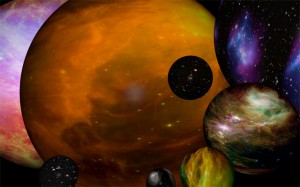 |
| In the multiverse scenario a vast and diverse array of bubble universes fluctuate into existence inside a larger vacuum. A small fraction of the universes have physical properties conducive to life. |
On an overcast afternoon in late April, physics professors and students crowded into a wood-paneled lecture hall at Columbia University for a talk by Nima Arkani-Hamed, a high-profile theorist visiting from the Institute for Advanced Study in nearby Princeton, N.J. With his dark, shoulder-length hair shoved behind his ears, Arkani-Hamed laid out the dual, seemingly contradictory implications of recent experimental results at the Large Hadron Collider in Europe.
“The universe is inevitable,” he declared. “The universe is impossible.”
The spectacular discovery of the Higgs boson in July 2012 confirmed a nearly 50-year-old theory of how elementary particles acquire mass, which enables them to form big structures such as galaxies and humans. “The fact that it was seen more or less where we expected to find it is a triumph for experiment, it’s a triumph for theory, and it’s an indication that physics works,” Arkani-Hamed told the crowd.
However, in order for the Higgs boson to make sense with the mass (or equivalent energy) it was determined to have, the LHC needed to find a swarm of other particles, too. None turned up.
With the discovery of only one particle, the LHC experiments deepened a profound problem in physics that had been brewing for decades. Modern equations seem to capture reality with breathtaking accuracy, correctly predicting the values of many constants of nature and the existence of particles like the Higgs. Yet a few constants — including the mass of the Higgs boson — are exponentially different from what these trusted laws indicate they should be, in ways that would rule out any chance of life, unless the universe is shaped by inexplicable fine-tunings and cancellations.
In peril is the notion of “naturalness,” Albert Einstein’s dream that the laws of nature are sublimely beautiful, inevitable and self-contained. Without it, physicists face the harsh prospect that those laws are just an arbitrary, messy outcome of random fluctuations in the fabric of space and time.
To explain this absurd bit of luck, the multiverse idea has been growing mainstream in cosmology circles over the past few decades. It got a credibility boost in 1987 when the Nobel Prize-winning physicist Steven Weinberg, now a professor at the University of Texas at Austin, calculated that the cosmological constant of our universe is expected in the multiverse scenario. Of the possible universes capable of supporting life — the only ones that can be observed and contemplated in the first place — ours is among the least fine-tuned. “If the cosmological constant were much larger than the observed value, say by a factor of 10, then we would have no galaxies,” explained Alexander Vilenkin, a cosmologist and multiverse theorist at Tufts University. “It’s hard to imagine how life might exist in such a universe.”
Simon Science Quanta Magazine: Is Nature Unnatural?
Comments